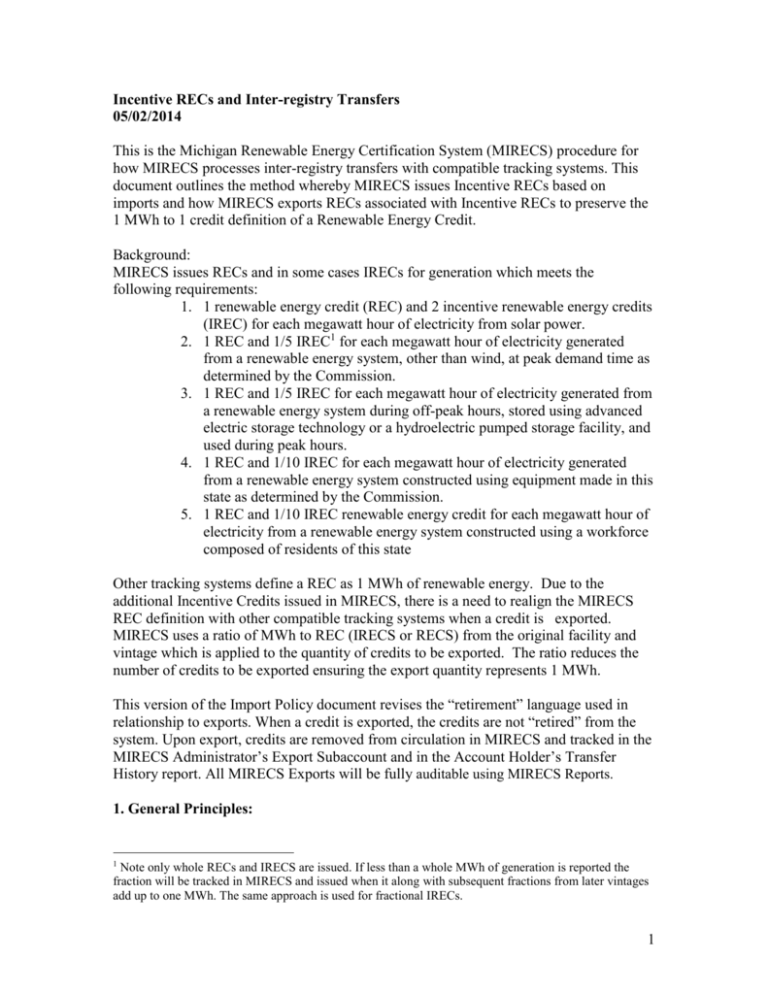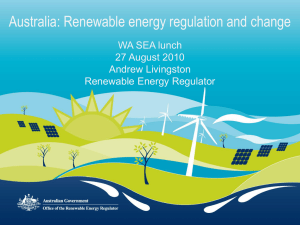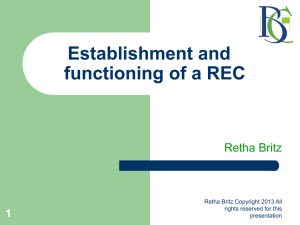Import/Export IRECs
advertisement

Incentive RECs and Inter-registry Transfers 05/02/2014 This is the Michigan Renewable Energy Certification System (MIRECS) procedure for how MIRECS processes inter-registry transfers with compatible tracking systems. This document outlines the method whereby MIRECS issues Incentive RECs based on imports and how MIRECS exports RECs associated with Incentive RECs to preserve the 1 MWh to 1 credit definition of a Renewable Energy Credit. Background: MIRECS issues RECs and in some cases IRECs for generation which meets the following requirements: 1. 1 renewable energy credit (REC) and 2 incentive renewable energy credits (IREC) for each megawatt hour of electricity from solar power. 2. 1 REC and 1/5 IREC1 for each megawatt hour of electricity generated from a renewable energy system, other than wind, at peak demand time as determined by the Commission. 3. 1 REC and 1/5 IREC for each megawatt hour of electricity generated from a renewable energy system during off-peak hours, stored using advanced electric storage technology or a hydroelectric pumped storage facility, and used during peak hours. 4. 1 REC and 1/10 IREC for each megawatt hour of electricity generated from a renewable energy system constructed using equipment made in this state as determined by the Commission. 5. 1 REC and 1/10 IREC renewable energy credit for each megawatt hour of electricity from a renewable energy system constructed using a workforce composed of residents of this state Other tracking systems define a REC as 1 MWh of renewable energy. Due to the additional Incentive Credits issued in MIRECS, there is a need to realign the MIRECS REC definition with other compatible tracking systems when a credit is exported. MIRECS uses a ratio of MWh to REC (IRECS or RECS) from the original facility and vintage which is applied to the quantity of credits to be exported. The ratio reduces the number of credits to be exported ensuring the export quantity represents 1 MWh. This version of the Import Policy document revises the “retirement” language used in relationship to exports. When a credit is exported, the credits are not “retired” from the system. Upon export, credits are removed from circulation in MIRECS and tracked in the MIRECS Administrator’s Export Subaccount and in the Account Holder’s Transfer History report. All MIRECS Exports will be fully auditable using MIRECS Reports. 1. General Principles: 1 Note only whole RECs and IRECS are issued. If less than a whole MWh of generation is reported the fraction will be tracked in MIRECS and issued when it along with subsequent fractions from later vintages add up to one MWh. The same approach is used for fractional IRECs. 1 1. Projects that are registered in other tracking systems are eligible for Incentive RECs (IRECs) if they are certified as Import projects in MIRECS and qualify according to Michigan PA 295. 2. IRECs will only be issued in correspondence to the RECs imported into MIRECS 3. The same affidavits will be required of Import Projects that denote eligibilities for IRECs as for regular MIRECS projects 4. Other registries define a whole credit as the environmental attributes derived from 1 MWH of generation from a Renewable Project while MIRECS creates Incentive Renewable Energy Credits and RECS for each MWh based on various criteria described in Michigan Public Act 295 Sec 39. Accordingly, an adjustment of MIRECS Credits will have to occur in response to each export to align each MIRECS REC with the 1 REC to 1 MWh definition of a whole credit. 5. RECs and IRECs issued for the same generation vintage, facility and fuel type will sometimes be owned by different parties 6. The account in which IRECs are issued does not equate legal ownership of the IRECs. The ownership of IRECs is determined by contracts exogenous to the registry. 7. This procedure will not ensure that every state will accept credits originated from MIRECS. This procedure only provides a fully auditable and transparent methodology whereby MIRECS can export to compatible tracking systems using a shared definition of a whole credit. 2. Issuing IRECs based on REC Imports: Based on previous decisions by the Michigan Commission as well as the rules of other tracking systems (including MRETS) IRECs will only be issued for generation for which the RECs have been imported into MIRECS. The IRECs associated with imported RECs will be issued to the REC owner. The Project owner is still required to fill out the affidavits and report on-peak generation but the IRECs are issued in the account of the REC owner. The IRECS created based on REC Imports may have a fraction associated with them. When this occurs, the fractional IRECS will be rounded down, and the remaining fractional amount will be tracked in an import report called Import Fractional Credits. Import Fractional Credits Report: This report will keep track of all of the fractional IRECs that have been imported and will give the receiving account holder the ability to retrieve whole IRECs once achieved. The report will be designed capturing fields similar to the current report tracking fractional RECs. Importing projects owner enters Total Generation and On-peak Generation on a per vintage basis. The fuel allocation will not change between Total Generation and On-peak Generation. The image below shows the data fields, marked by arrows, a project owner would need to enter 2 3. Exporting RECs Associated with Incentive RECs Based on previous decisions by the Michigan Commission as well as the rules of other tracking systems (including MRETS) RECs can only be exported if an adjustment is made to cancel out a proportional amount of RECs and/or IRECs that were created in excess of the 1 MWh to 1 REC definition of a whole credit. Any process for handling exports must consider the fact that IRECs and RECs may be owned by different parties in MIRECS and that the ratio of IRECs issued for a given project is not constant from month to month. The approach must also recognize that in the eyes of the Michigan Commission an IREC is equal to a REC for compliance purposes (i.e. they can be substituted for each other with no limits). The general approach is that if a purchaser of RECs exports them they are reduced based on the MWh-to-REC ratio from the associated REC Facility and vintage. This will work in the following way: A public report has been added which lists the ratio of MIRECS RECs (IRECS or RECS) issued for each MWh of generation from the facility by month.2 For example, if 1 REC and 3 IRECs are issued for 1 MWh of generation the MWh to REC ratio is 1 to 4 (or 0.25). If 10 RECs and 5 IRECs are issued for 10 MWhs of generation, the ratio is 10 to 15 (or 0.67) and so forth. This report enables the owner of the RECs 2 The report looks similar to the MIRECS Projects report but with a column listing the ratios. At the top users can select which generation month to look at from a drop-down. 3 (who may be different than the project owner) to see how many MWh of renewable generation was actually produced to create the RECs. Also, this ratio is carried with each credit similar to the way the serial number or eligibility is carried with each credit. The MWh – Credit Ratio report is provided publicly to offer the conversion value of each facility and vintage to any potential owner of the Credits. When an export is initiated, MIRECS will display the total number of MWhs being exported, the corresponding number of MIRECS RECs being removed from MIRECS circulation and the proportional quantity of RECS being transferred to the compatible tracking system. The quantity of MWh exported will be equal to the total MIRECS RECs selected for export multiplied by the corresponding MWh-to-REC ratio. For example, an account holder selects to export 50 RECs (Jan 2010 from Project GEN-100) with an MWh-toREC ratio of 0.5. In this case 50 MIRECS RECs will be removed from circulation and 25 MWh will be processed for export and eventual import in another tracking system. The imported RECS will correspond to the vintage and facility of the RECS exported from MIRECS (Jan 2010 from Project GEN 100). The table below shows the process for a variety of different ratios: Scenario MWh of Generation MIRECS RECs Issued MIRECS IRECs Issued MWhto-RECs Ratio 1 2 3 4 5 6 7 8 9 500 1000 500 1000 500 1000 500 1000 500 500 1000 500 1000 500 1000 500 1000 500 125 250 250 500 500 1000 1000 2000 125 0.8 0.8 0.67 0.67 0.5 0.5 0.33 0.33 0.8 RECs selected for export from MIRECS 500 1000 500 1000 500 1000 500 1000 625 Import RECs issued in MRETS 400 800 333 666 250 500 167 333 500 The end result of this process, for example, is that for scenario 1 above, a total of 525 credits are in circulation among the various tracking systems: 400 RECs in the import registry (i.e. MRETS) and 125 IRECs in MIRECS. The 400 RECs in MRETS represent 400 MWhs of generation. The 125 RECs remaining in MIRECS still carry the MWh-to-REC ratio of 0.8 and therefore still represent only 100 MWh of generation. This is the desired result as the credits are based on 500 MWh of generation. Scenario 9 illustrates that in order for all generation from a particular vintage to be exported from MIRECS to a compatible tracking system, all credits issued for the project and vintage would need to be exported. 625 credits (RECs and IRECs) representing 500MWh would be exported, resulting in 500 RECs imported into the compatible tracking system. By applying a ratio that represents the proportionate amount of actual MWh of renewable generation, all RECs (including IRECs) in MIRECS have the same value. 4 Any REC or IREC can be exported to another tracking system because it will be “discounted” to reflect the additional Michigan Incentive Credits created from the MWh of generation. All RECs (including IRECs) will represent a portion of an MWh of actual renewable generation. This approach is desirable because it can be applied to all tracking systems. Ultimately, the information used for import by the tracking systems will be MWh of renewable generation. This will allow each tracking system to apply whatever types of incentives are desired, if any, to the various MWh imported. Each MIRECS REC removed from circulation upon export will be tracked in 2 reports: MIRECS Administrator’s Export Subaccount and the MIRECS Account Holder’s Transfer History Report. These reports will correspond to the Account Holder’s Transfer History Report in the compatible tracking system that accepted the MIRECS export. These reports will provide a transparent and fully auditable trail to track inter-registry transfers. The RECs and IRECs that are exported from MIRECS may have a fraction associated with them. When this occurs, the fractional RECs and IRECs will be rounded down and no longer tracked. There are potential complications that can occur with exporting credits from multifuel projects where one of the fuel types is either solar or a qualifying off-peak storage technology. However, none of these multifuel project combinations exist today in MIRECS so we propose to table this implementation issue until such time the Commission notifies APX, Inc. of such a facility being developed. Imported Credits cannot be exported to other registries to eliminate the potential for gaming MIRECS for Incentive RECs. 5







